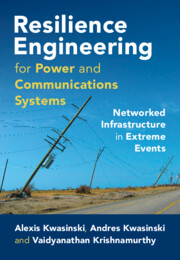 Resilience Engineering for Power and Communications Systems
Resilience Engineering for Power and Communications Systems Published online by Cambridge University Press: 04 January 2024
The increased interest that the topic of critical infrastructure resilience is attracting in academia, government, commerce, services, and industry is creating an alternative engineering field that could be called resilience engineering. However, the views of the meaning of resilience have varied, and even in some very relevant world languages, an exact translation of the word “resilience” has only recently been introduced – for example, the word “resiliencia” was added to the dictionary of the Royal Academy of Spanish Language in 2014 – or it still does not exist, as happens in Japanese. Thus, this chapter introduces the main concepts associated with the study of resilience engineering applicable to critical infrastructure systems with a focus on electric power grids and information and communication networks (ICNs) because these are the infrastructures that are identified as “uniquely critical” in US Presidential Policy Directive 21, which is the source for the definition of resilience that is used in this book.
To save this book to your Kindle, first ensure no-reply@cambridge.org is added to your Approved Personal Document E-mail List under your Personal Document Settings on the Manage Your Content and Devices page of your Amazon account. Then enter the ‘name’ part of your Kindle email address below. Find out more about saving to your Kindle.
Note you can select to save to either the @free.kindle.com or @kindle.com variations. ‘@free.kindle.com’ emails are free but can only be saved to your device when it is connected to wi-fi. ‘@kindle.com’ emails can be delivered even when you are not connected to wi-fi, but note that service fees apply.
Find out more about the Kindle Personal Document Service.
To save content items to your account, please confirm that you agree to abide by our usage policies. If this is the first time you use this feature, you will be asked to authorise Cambridge Core to connect with your account. Find out more about saving content to Dropbox.
To save content items to your account, please confirm that you agree to abide by our usage policies. If this is the first time you use this feature, you will be asked to authorise Cambridge Core to connect with your account. Find out more about saving content to Google Drive.